Stepping Stones and Pathways
Japanese Garden Design
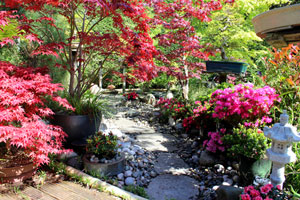
The world-famous Japanese tea ceremony is what so many people think of when they picture an oriental garden, with the teahouse itself being reached along a narrow footpath known in Japan as a 'roji'.
Stepping stones or 'tobi-ishi' were often used to create this naturalistic walkway, being an intergral part of the journey.
Design History
This initial part of the garden layout was designed to set the spiritual theme and allow visitors to relax as they amble along, leaving the troubles of the real world behind them and clearing their minds ready for a spot of contemplation and meditation.
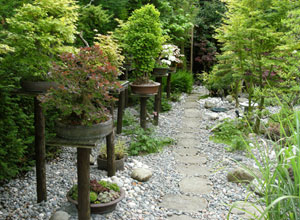
Today, a footpath serves as much more than just a way to walk around the garden. It should be designed to take you on a journey past the main points of interest, while edging and separating different areas.
Style and Layout
Ideally pathways should be fairly irregular, rather than completely straight, although some straight sections may be appropriate to link areas.
As you walk along the path, you should catch glimpses of other parts of the garden, which may be partially obscured by the branch of a large Japanese maple or the canes of a clump of bamboo.
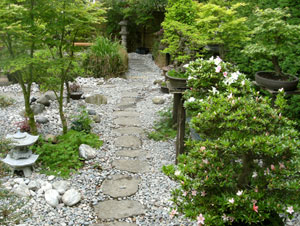
By designing your Japanese garden so that it can't all be seen at once, it will be much more interesting to walk around and explore.
A subtle focal point at the end of a pathway often makes sense, such as a tall pagoda or granite lantern, giving a reason to walk along the path. These objects can also be placed along the route, with Japanese lanterns being originally designed to illuminate footpaths in the evenings and at night.
Suitable Materials
What you decide to make your pathway from is very much personal taste, although many Japanese gardens use a combination of different materials for different sections. These include simplistic footpaths of fine gravel or pebbles, granite slabs and blocks cemented together to create an abstract pattern, crazy paving slabs, and stepping stones of various different sizes.
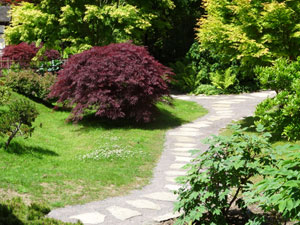
Types of Stepping Stones
Stepping stones are such an effective addition to any landscaped Japanese garden, immediately imparting a really authentic oriental personality to any man-made landscape and often being surrounded by gravel, small pebbles or moss.
Raised stones should be laid to appear quite natural, with a choice of different flat stones coming in various shapes and sizes, and prices. It can be quite difficult to find numerous 'matching' stepping stones when laying out a garden, with reclamation yards being worth a look.
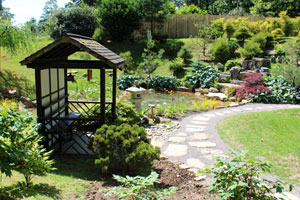
Costs and Budget Options
If the overall cost becomes just too expensive, then you can actually purchase some moulded stepping stones from most large garden centres, which are made from coloured concrete and soon weather to appear extremely realistic.
They often only come in three or four different shapes and designs, although when placed on the ground, if positioned at different angles, the shapes soon appear completely random and individual.
Not only do these artificial stepping stones have the distinct advantage of being far more affordable, but they are easier to lay, having completely flat bottoms and being all the same thickness. You can even buy some moulds and make your very own stepping stones from a concrete mixture with added peat, so that they will naturally weather more quickly.
 The world-famous Japanese tea ceremony is what so many people think of when they picture an oriental garden, with the teahouse itself being reached along a narrow footpath known in Japan as a 'roji'.
The world-famous Japanese tea ceremony is what so many people think of when they picture an oriental garden, with the teahouse itself being reached along a narrow footpath known in Japan as a 'roji'. Today, a footpath serves as much more than just a way to walk around the garden. It should be designed to take you on a journey past the main points of interest, while edging and separating different areas.
Today, a footpath serves as much more than just a way to walk around the garden. It should be designed to take you on a journey past the main points of interest, while edging and separating different areas. By designing your Japanese garden so that it can't all be seen at once, it will be much more interesting to walk around and explore.
By designing your Japanese garden so that it can't all be seen at once, it will be much more interesting to walk around and explore.
